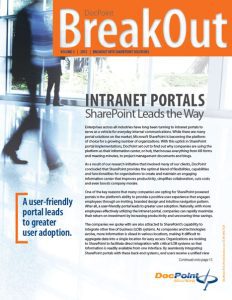We all know that Microsoft SharePoint originated as a collaboration platform, helping organizations share information and manage documents. However, like any other technology, SharePoint has evolved over the past decade, growing into a full-fledged enterprise content management (ECM) solution, with seemingly endless possibilities. But, what’s next?
Today, everyone talks about “big data.” Enterprises have prolific amounts of information coming from a range of sources and lines of business applications. What if you could assimilate data from each system—whether ERP, financial, or CRM—into a centralized, user-friendly dashboard to obtain an overall view of your business processes?
This is where SharePoint is headed. Now that it has demonstrated its ability to serve as a corporate intranet portal, the next step in maximizing SharePoint’s value is to use it as a business intelligence solution. When properly designed, implemented and integrated with other lines of business applications, a SharePoint portal can provide real-time transparency and reporting capabilities, pulling data from various systems into one dashboard. With this high level of insight, you can easily make subtle changes and drive continuous improvement, as opposed to calling weekly departmental meetings to compare notes or waiting until something goes wrong to modify your processes.
Also, SharePoint’s cloud and hybrid deployment options allow you to take this business intelligence one step further – providing the ability to access the same data from anywhere via a mobile device. With all of this information literally at your fingertips, managers can make decisions faster without the need to rely on other people. As a result, overall business performance and processes will be improved, executives will be empowered to monitor and improve their business operations in real time, and organizations will obtain a faster ROI on their SharePoint investment.

